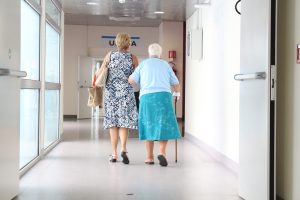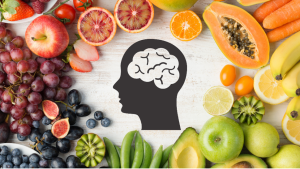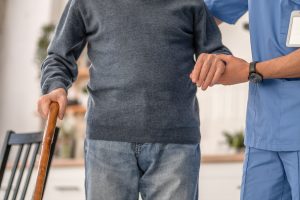By Vanessa Carmody OTD, OTR/L,CAPS
Dr. Carmody is an academic professor with specialized expertise in community-based programming, research, and education for people with neurodegenerative conditions. She is a board-certified occupational therapist and a certified aging-in-place specialist.
There are several methods for addressing balance deficits with the intention of preventing falls. Physical and occupational therapists, along with community-based skilled programs, can employ several methods to directly address fall prevention, including:
- Balance training is a type of exercise that helps you improve your ability to stay stable and avoid falling. It’s done in a safe and supervised environment. During balance training, you’ll be asked to do things that challenge your balance, like reaching outside of your usual support area. The exercises might also include changes to your attention, vision, stance, or position. All these challenges will help you build your balance skills and stay steady on your feet.
- Goal-based or activity-based exercise is a type of exercise that has a specific goal in mind. For example, the goal could be to pick up a grandchild or to be able to get up from a chair more easily. The exercises are designed to help you achieve these goals, rather than just focusing on how many repetitions you do or how much weight you lift. An occupational therapist can be especially helpful in guiding you with these exercises.
- Strength and flexibility training is important for balance, especially in the core, big joints like hips, knees, and shoulders, small joints like feet and ankles, and in the spine. By working on these areas, you can improve your balance and prevent falls.
- Cardio-endurance exercise is a type of physical activity that increases your heart rate and breathing rate for an extended period. It’s important to keep doing this type of exercise to keep your heart healthy, stabilize your joints, and promote good blood flow throughout your body, especially to your brain. Regular vigorous exercise may also have a protective effect on your brain as you age, beyond just the general health benefits.
- Changing the way we do certain tasks can also help improve our balance and safety. This may involve using tools or adapting the way we sit or stand while doing things like putting on pants or using the bathroom. However, it’s important to work with a therapist to make sure that the tools or methods we use are necessary and don’t make us rely on them too much. Sometimes, using a different posture or slowing down can also help improve safety. It may take some time and practice to find what works best for us and our environment, and a therapist can help with this process.
- When we try to do too many things at once, it can be tiring and difficult for our brains. People with Parkinson’s disease may have even more trouble with this because of changes in their brain chemistry. Contrary to popular belief, our brains cannot truly multitask. Instead, we rapidly shift our attention between different tasks, which can be tiring and less efficient as we age. In individuals with Parkinson’s disease, the basal ganglia – the “composer” of our brain responsible for switching attention and enabling multitasking – is damaged by the disease process since it relies on dopamine to function properly. However, there are some techniques like mindfulness training, conscious attention training, and visualization that can help us focus on one task at a time and complete it more safely and effectively.
- Breaking things down into smaller goals can activate our brain’s reward system more frequently, resulting in a more efficient use of dopamine. This method also allows for extra practice and attention on specific elements, promoting success and helping the brain relearn lost skills or learn new ones.
Supportive environments are essential in preventing falls and promoting stability. Occupational therapists trained in environmental safety and modification can provide valuable assessments of environments and suggest methods such as decluttering, increasing lighting, and adding support and nonskid mats to promote safe and effective participation.



